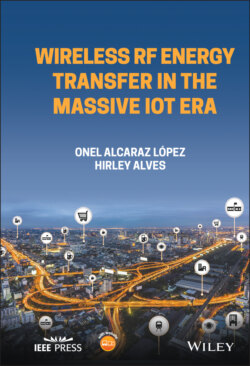Читать книгу Wireless RF Energy Transfer in the Massive IoT Era - Hirley Alves - Страница 14
1.1 Selected Use-cases and Scenarios
ОглавлениеThere is a large variety of use-cases in many industries and societies. Herein we highlight a few, while in Chapter 2, we provide even more examples in the context of massive WET.
The number of potential applications is as massive as number of devices in massive IoT, with diverse requirements in cost, energy efficiency, coverage, performance (for instance, reliability, latency, throughput, capacity, to name a few), and security.
Many IoT devices, namely MTDs, send only a few messages on a given period, such as an hour, or a day or week, while others may send more frequent updates or need higher data rate, voice traffic, or security. Figure 1.3 provides some use-cases and applications of massive IoT.
Figure 1.1 Illustrative massive IoT use-cases.
Smart metering, such as for electricity, water, or gas, is a successful example of massive IoT deployment. In this case, devices often require periodic updates on consumption readings to a remote server or cloud. Moreover, the smart meter can operate under alarm mode when an outage happens, and receive requests or commands remotely.
E-health life sign monitoring and wearables may require a minute or even second-level updates, which demand reliable connections and increase traffic over the network. In large medical facilities, positioning and tracking can be realized in real-time, facilitating resource management and improving efficient care. These cases need deep indoor coverage as the extensive facilities have many floors and underground corridors connecting different places.
Other applications in agriculture, transport, and industry may require voice commands and higher data rates. For instance, in smart agriculture, monitoring climate conditions and crop management is essential for precision farming since sensors gather information on climate conditions and humidity, leaf water potential, and other characteristics to monitor crop health. This data is collected and conveyed periodically, for example, hourly or daily. Some applications frequently upload images to a cloud (or remote server), which demands higher throughput.
